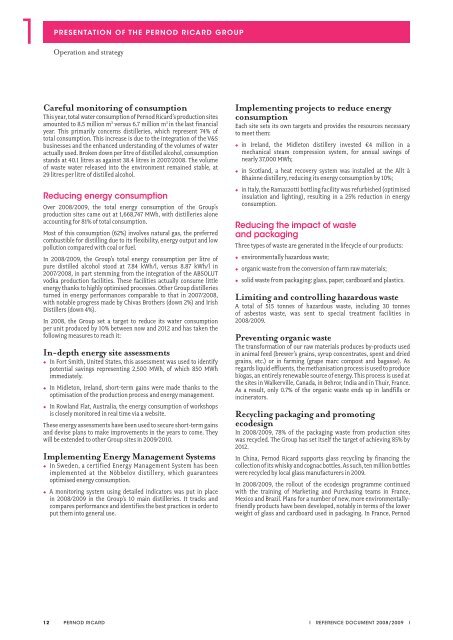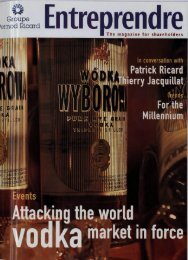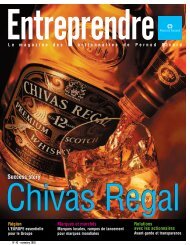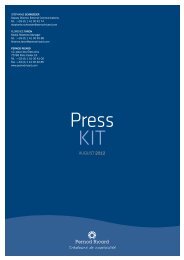Registration Document - Pernod Ricard
Registration Document - Pernod Ricard
Registration Document - Pernod Ricard
You also want an ePaper? Increase the reach of your titles
YUMPU automatically turns print PDFs into web optimized ePapers that Google loves.
1 Operation<br />
12<br />
PRESENTATION OF THE PERNOD RICARD GROUP<br />
and strategy<br />
Careful monitoring of consumption<br />
This year, total water consumption of <strong>Pernod</strong> <strong>Ricard</strong>’s production sites<br />
amounted to 8.5 million m 3 versus 6.7 million m 3 in the last financial<br />
year . This primarily concerns distilleries, which represent 74% of<br />
total consumption. This increase is due to the integration of the V&S<br />
businesses and the enhanced understanding of the volumes of water<br />
actually used. Broken down per litre of distilled alcohol, consumption<br />
stands at 40.1 litres as against 38.4 litres in 2007/2008. The volume<br />
of waste water released into the environment remained stable, at<br />
29 litres per litre of distilled alcohol.<br />
Reducing energy consumption<br />
Over 2008/2009, the total energy consumption of the Group’s<br />
production sites came out at 1,668,747 MWh, with distilleries alone<br />
accounting for 81% of total consumption.<br />
Most of this consumption (62 %) involves natural gas, the preferred<br />
combustible for distilling due to its flexibility, energy output and low<br />
pollution compared with coal or fuel.<br />
In 2008/2009, the Group’s total energy consumption per litre of<br />
pure distilled alcohol stood at 7.84 kWh/l, versus 8.87 kWh/l in<br />
2007/2008, in part stemming from the integration of the ABSOLUT<br />
vodka production facilities. These facilities actually consume little<br />
energy thanks to highly optimised processes. Other Group distilleries<br />
turned in energy performances comparable to that in 2007/2008,<br />
with notable progress made by Chivas Brothers (down 2%) and Irish<br />
Distillers (down 4%).<br />
In 2008, the Group set a target to reduce its water consumption<br />
per unit produced by 10% between now and 2012 and has taken the<br />
following measures to reach it:<br />
In-depth energy site assessments<br />
◆ In Fort Smith, United States, this assessment was used to identify<br />
potential savings representing 2,500 MWh, of which 850 MWh<br />
immediately.<br />
◆ In Midleton, Ireland, short-term gains were made thanks to the<br />
optimisation of the production process and energy management.<br />
◆ In Rowland Flat, Australia, the energy consumption of workshops<br />
is closely monitored in real time via a website.<br />
These energy assessments have been used to secure short-term gains<br />
and devise plans to make improvements in the years to come. They<br />
will be extended to other Group sites in 2009/2010.<br />
Implementing Energy Management Systems<br />
◆ In Sweden, a certified Energy Management System has been<br />
implemented at the Nöbbelov distillery, which guarantees<br />
optimised energy consumption.<br />
◆ A monitoring system using detailed indicators was put in place<br />
in 2008/2009 in the Group’s 10 main distilleries. It tracks and<br />
compares performance and identifies the best practices in order to<br />
put them into general use.<br />
PERNOD RICARD<br />
Implementing projects to reduce energy<br />
consumption<br />
Each site sets its own targets and provides the resources necessary<br />
to meet them:<br />
◆ in<br />
Ireland, the Midleton distillery invested €4 million in a<br />
mechanical steam compression system, for annual savings of<br />
nearly 37,000 MWh;<br />
◆ in<br />
Scotland, a heat recovery system was installed at the Allt à<br />
Bhainne distillery, reducing its energy consumption by 10%;<br />
◆ in<br />
Italy, the Ramazzotti bottling facility was refurbished (optimised<br />
insulation and lighting), resulting in a 25% reduction in energy<br />
consumption.<br />
Reducing the impact of waste<br />
and packaging<br />
Three types of waste are generated in the lifecycle of our products:<br />
◆ environmentally hazardous waste;<br />
◆<br />
organic waste from the conversion of farm raw materials;<br />
◆ solid waste from packaging: glass, paper, cardboard and plastics.<br />
Limiting and controlling hazardous waste<br />
A total of 515 tonnes of hazardous waste, including 30 tonnes<br />
of asbestos waste, was sent to special treatment facilities in<br />
2008/2009.<br />
Preventing organic waste<br />
The transformation of our raw materials produces by-products used<br />
in animal feed (brewer’s grains, syrup concentrates, spent and dried<br />
grains, etc.) or in farming (grape marc compost and bagasse). As<br />
regards liquid effluents, the methanisation process is used to produce<br />
biogas, an entirely renewable source of energy. This process is used at<br />
the sites in Walkerville, Canada, in Behror, India and in Thuir, France.<br />
As a result, only 0.7% of the organic waste ends up in landfills or<br />
incinerators.<br />
Recycling packaging and promoting<br />
ecodesign<br />
In 2008/2009, 78% of the packaging waste from production sites<br />
was recycled. The Group has set itself the target of achieving 85% by<br />
2012.<br />
In China, <strong>Pernod</strong> <strong>Ricard</strong> supports glass recycling by financing the<br />
collection of its whisky and cognac bottles. As such, ten million bottles<br />
were recycled by local glass manufacturers in 2009.<br />
In 2008/2009, the rollout of the ecodesign programme continued<br />
with the training of Marketing and Purchasing teams in France,<br />
Mexico and Brazil. Plans for a number of new, more environmentallyfriendly<br />
products have been developed, notably in terms of the lower<br />
weight of glass and cardboard used in packaging. In France, <strong>Pernod</strong><br />
I REFERENCE DOCUMENT 2008/2009 I
















